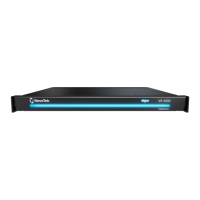Page | 8
Skype TX, in simplest terms, is a studio-grade version of the familiar Skype™ client software,
developed by Microsoft® to let broadcasters integrate Skype technology into production
infrastructure. Both Talkshow models support the most recent Skype TX 4 platform. In
practice, you can think of Skype TX as your ‘switchboard’. It provides the connections
between your local unit and the worldwide Skype network. You use Skype TX to log into a
Skype account, and initiate, receive and manage calls on connected TalkShow systems.
The Skype TX control application allows you to connect, control and operate multiple
TalkShow VS 4000 and/or VS100 units on the same network from a unified interface, hosting
up to four simultaneous Skype calls for a VS 4000, and one per connected VS100 system.
Skype TX can operate locally on a TalkShow VS 4000 or VS 100, or remotely – on another
network-connected system.
TalkShow software completes the suite, providing extensive audio and video configuration
tools, settings and monitoring features for each of the four Skype ‘channels’ it provides.
SECTION 2.3 FEATURES
Let’s take time for a brief overview of just some of the key features of your TalkShow system.
2.3.1 PHYSICAL
Rugged 1RU rack-mount chassis.
All audio and video, monitoring and network connectors are easily accessible from the rear
for convenient installation in industry standard configurations.
Audio and video connectors are industry standard – XLR and ¼” TRS, or BNC as appropriate
– to ensure broad studio compatibility and secure connections.
Dual gigabit network ports provide ample connectivity for both local and internet needs.
2.3.2 A/V INPUT AND OUTPUT
HD-SDI BNC connectors for video input and output.
XLR inputs and outputs for analog audio i/o.
¼” TRS (balanced, line level) Phones output for local call output monitoring.
Complete NDI™ (Network Device Interface) a/v input and output support provides ultimate
‘video over ip’ functionality, allowing you to completely eliminate bulky SDI or analog cable
runs. Transmit or receive high quality, low latency a/v signals output the local network, and
easily re-route signals entirely in software.
Unique Talk Back feature allows in-studio personnel (such as a director or call-screener) to
converse privately with the remote caller without requiring external audio interrupt
solutions.

